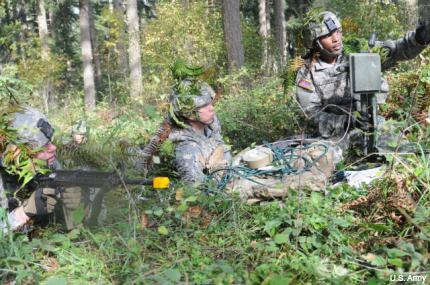Cyber warriors take to the battlefield
Armed and in full camo, an Army team gives a mission force valuable real-time information during a recent exercise.

Members of the cyber intelligence team set up to support a mission.
As cyber operations become more of a presence on the battlefield, so, too, will cyber warriors.
At an exercise last week at Joint Base Lewis-McChord, Wash., the Army offered one version of what they would look like. Basically, they’d look like other soldiers on a mission—full camouflage, weapons and equipment in tow, crawling through the brush to stay out of sight. After setting up their computers and equipment, the cyber and intelligence team provided real-time intelligence to a brigade combat team whose mission was to find and capture a high-value target hiding in a crowded, multi-building compound.
"The cyber element was able to provide intelligence to myself on the ground that enhanced [intelligence] information that made the picture of the battlefield much more clear," 1st Lt. Kenneth Medina, who led the mission, said in an Army release. "When you incorporate cyber into that you gain a much higher degree of accuracy on the target and you can paint a much clearer picture of the objective area."
Medina noted that such missions ordinarily rely on information that was gathered in advance and could be out of date by the time a mission force arrives. In this case, though, "The cyber element was able to monitor some of the digital traffic that was moving through the village and the compound. They were able to relay that information to me via radio, and I was able to take action on that intelligence that they gave me in the village in real time," he said.
That information also is useful in urban settings, where it can be difficult to tell terrorist and non-participants apart, he said.
The integrated cyber and intelligence team was made up of soldiers from the 2nd Stryker Brigade Combat Team, 2nd Infantry, known as 2-2 ID, the 201st Expeditionary Military Intelligence Brigade and the 780th Military Intelligence Brigade out of Fort Meade, Md. The integrated team is preparing for a new cyber enemy it will meet early in 2016 at the National Training Center at Fort Irwin, Calif., the Army said.
The exercise, part of a roughly year-long pilot to incorporate cyber operations at the corps level and below, also reflects the Defense Department’s broader efforts to incorporate cyber and electronic warfare components all of its operations. Last November, for instance, the Marines incorporated cyber capabilities into its Bold Alligator exercise, making use of the Office of Naval Research’s Tactical Cyber Range. That set of technologies combines networking, communications, sensors, unmanned systems and augmented reality (complete with Google Glass-like goggles) in a mobile set-up.
The up-to-date intelligence battlefield cyber operations provide can improve operational efficiency, but they’re also seen as necessary, because cyber is no longer a one-way street.
"If we look at what's going on in the world, whether it's what's going on in Southwest Asia with ISIL or what's going on in EUCOM [U.S. European Command] with the crisis in Ukraine, we've seen that our peer competitors or adversaries are very aggressively using cyberspace to support their operations," Col. William J. Hartman, commander of the 780th Military Intelligence Brigade, said at the recent Army exercise. "As an Army, we have to understand that environment."
During the Army’s large-scale Network Integration Evaluation in September, in fact, Col. Chuck Masaracchia, said he considered cyberattacks on the tactical network to be the biggest threat the Army faces on the battlefield.
NEXT STORY: Army unsheathes Excalibur supercomputer




